Index

Review: The best Fermi overclocking potential so far
GTX 465 uses a scaled down version of the GF100 chip; more precisely the chips that haven’t qualified to run on GTX 480 and GTX 470 cards made their way to the GTX 465. Full version of GF100 packs 16 Streaming Multiprocessors (SM) whereas the GTX 465 comes with only 11 SMs and 352 shader processors. Let us clarify – one SM packs 32 shader processors (SPs), or CUDA cores as Nvidia likes to call them. GTX 470 comes with 14 SMs (448 SPs) whereas the GTX 480 comes with 15 SMs (480 SPs). This means that none of these cards use the full potential of the GF100.
The announcement of Fermi GF100 chip also brought about Nvidia’s usage of GDDR5 memory on high-end cards. Unlike AMD, who uses 256-bit memory interface and high-clocked GDDR5, Nvidia uses wider memory bus and slower GDDR5 memory.
Note that the GTX 480 uses 384-bit memory interface (3696MHz memory, 177.4 GB/s bandwidth), the GTX 470 uses 320-bit interface (3348MHz memory, 133.9 GB/s bandwidth) whereas the GTX 465 uses a 256-bit memory interface (3206MHz memory, 102.6 GB/s bandwidth). In comparison, the fastest AMD’s single GPU card, the HD 5870, uses 256-bit memory interface but faster memory (4800MHz memory, 153.6GB/s bandwidth). The HD 5850, which is the GTX 465’s direct competitor, uses 256-bit memory interface (4000MHz memory, 128GB/s bandwidth).
The GF100 is a complex chip made of four Graphics Processing Clusters (GPC), four Raster Engines, six memory controllers, six ROP clusters with 8 ROP units each and, as we said before, 16 SMs. Each ROP cluster is assigned one 64-bit memory controller. The GTX 465 packs 32 ROPs, meaning that compared to the GTX 480, it’s 2 ROPs and two memory controllers short (which at the same time explains the 256-bit memory interface)
Downclocking is the most common and logical way to make a visible difference between cards, but since the GTX 465’s GPU is scaled down in comparison to the GTX 470’s, Nvidia decided to leave the clocks unchanged (607MHz GPU, 1215MHz stream processors). Note that the GTX 480 runs at 700MHz for the GPU and 1401MHz for the shaders.
Gainward’s GTX 465 Good card runs at reference clocks and packs a reference video buffer with 1024MB of GDDR5 memory.
GF100 is an extremely fast and powerful graphics processor, but all this comes at a price. Namely, this GPU gets very hot and devising efficient cooling was no easy task. All three Fermi cards use Nvidia’s dual slot cooler which keeps the temperatures in check, but the fans run at a pretty high RPM and it directly translates into noise. Gainward, on the other hand, would have none of that and made its own cooler with two fans. The GTX 480’s TDP stands at 250W; the GTX 470’s is at 215W whereas the GTX 465 comes with a 200W TDP.
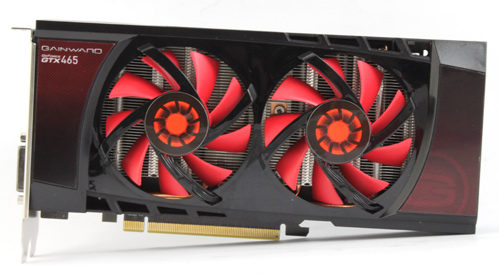
Packaging and Contents
Gainward prepared a new box design for the new Fermi cards. Now when the company is once again Premium Nvidia partner, Gainward didn’t miss out on the chance to emphasize that on the GTX 465’s box.

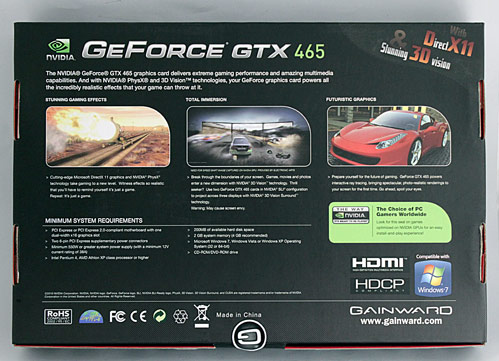
Users who buy Gainward’s cards based on the reference design receive an HDMI cable with a mini-HDMI connector, but the GTX 465 Good comes with full size HDMI so there’s no need for that. The only video out that’s not featured on the card is VGA, but if you do end up needing it, Gainward ships a DVI-to-VGA dongle with the card.
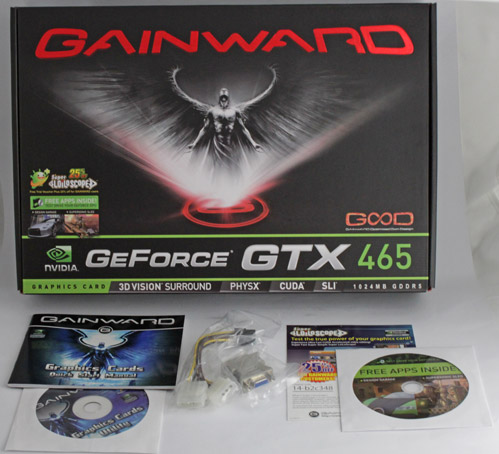
A closer look at Gainward GTX 465 Good Edition
Gainward GTX 465 Good Edition’s cooler comes with two fans. The fans are placed above the heatsink rather than in line with it (like on reference cooling), which allows for a larger heatsink. We didn’t like the fact that the cooler disperses heat within the case and only a fraction of hot air exits via I/O panel, but it’s still superior to the reference solution.
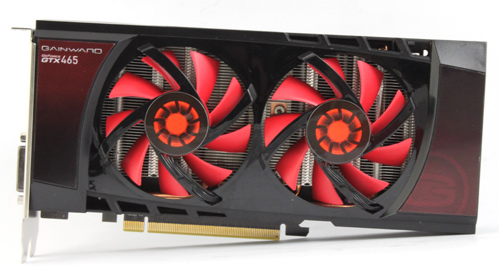
Since there’s not much airflow around the I/O panel and thus no need to convert one slot into an air outlet, Gainward pounched on the chance to put a DisplayPort video out. This makes Gainward’s GTX 465 Good is a video-out champ among Fermi cards, but unfortunately the GF100 will still limit you to two outs at the same time. If, however, you’re adamant to get that third video out, you’ll have to purchase another card.
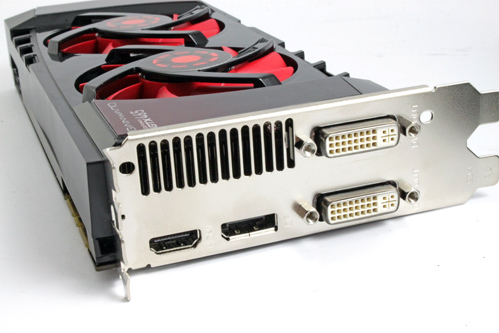
Below you see two cards – Gainward’s reference GTX 470 and Gainward’s GTX 465 Good. Since we don’t own a reference GTX 465 card we used the GTX 470 to demonstrate the differences, as both cards use the same I/O panel with identical set of outs, the same cooling and the same PCB.

Unlike previous Nvidia’s cards, Fermi cards no longer need a SPDIF cable, as an integrated audio processor takes care of audio via the PCIe bus.
The PCB on Gainward’s GTX 465 Good is 22.8cm long, compared to the 22.8cm long reference PCB.

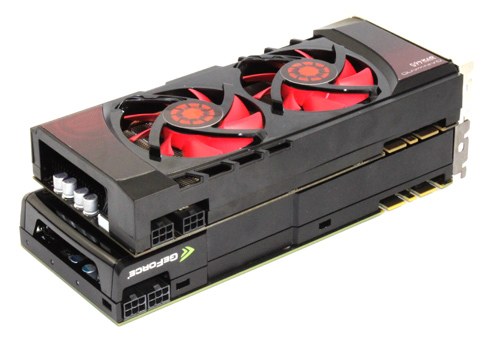
The card draws power via two PCIe connectors.

The GTX 465’s cooler takes care of memory as well as power regulation circuitry. The green areas you see on the picture are thermal components which are placed to be in direct contact with various PCB components.

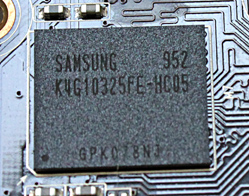
Three heatpipes route GPU heat to the far ends of the heatsink.
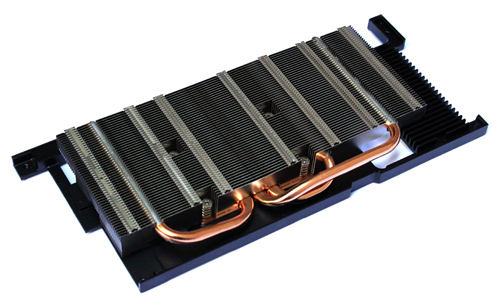
The fans are a part of the plastic hood. Both fans are on one 4-pin connector so RPM regulation will be easy.

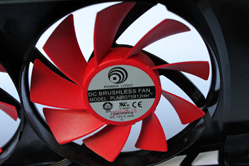
Like the reference card, Gainward’s Good Edition comes with SLI connectors.

Testbed:
Motherboard: EVGA 3xSLI
CPU: Core i7 965 XE (Intel EIST and Vdrop enabled)
Memory: 6GB Corsair Dominator 12800 7-7-7-24
Harddisk: OCZ Vertex 2 100 GB
Power Supply: CoolerMaster Ultimate 1100W
Case: Corsair Obsidian 800D
Fan Controler: Kaze Master Pro 5.25"
Operating System: Win7 64-bit
257.15_desktop_win7_winvista_64bit_english_beta
10.5 CCC

Futuremark Vantage
Nvidia built the GTX 465 to sit somewhere between the red camp’s HD 5850 and HD 5830 cards, but preliminary results show that the GTX 465 isn’t fast enough to beat the HD 5850. We’ll soon see whether Vantage results carry on to gaming as well.

Dirt 2
At 1920x1200, Gainward GTX 465 Good Edition shows that we’re talking about a good gaming card, but the HD 5850 is still beating it price-wise.

Switching to 2560x1600 sees the GTX 465 lag behind the HD 5850, to the point where the 5830 catches up with it. Still, even at this high resolution we still managed a playable framerate.

Metro 2033
Metro 2033 didn’t change much – we see that the GTX 465 beats the HD 5830 but is inferior to HD 5850. The GTX 470 scored about 28% better.

FurMark
GTX 465 didn’t do very well in FurMark, and this test see the card lose to HD 5830 for the first time.

Overclocking
Overclocking Gainward’s GTX 465 Good Edition wasn’t difficult and it generally went very well. We overclocked the GPU to the max in Gainward’s ExperTool v7.9, which was 790MHz.
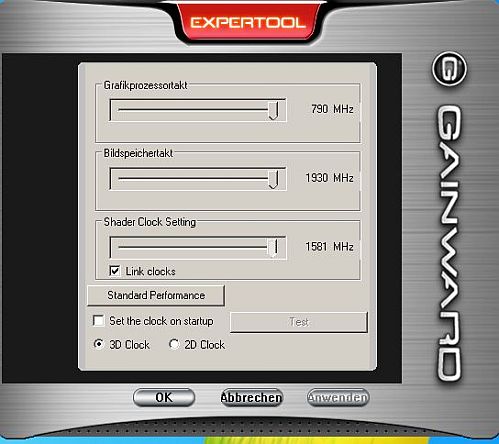
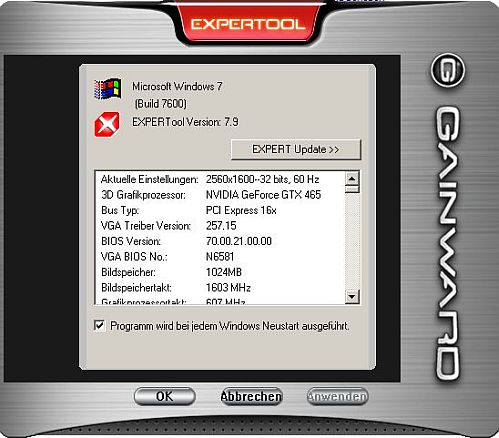
Since the card ran stable and GPU temperatures didn’t exceed 93°C (auto RPM regulation, 75% RPM speed), we decided to try our luck with MSI’s Afterburner tool v.1.6.9 Beta 5, but we couldn’t push the card further. Still, MSI allowed us to push memory further, and we achieved stable 1000MHz.
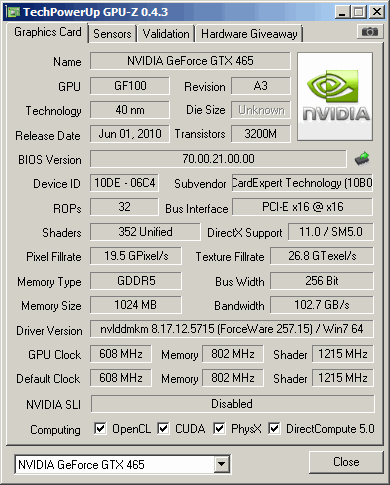
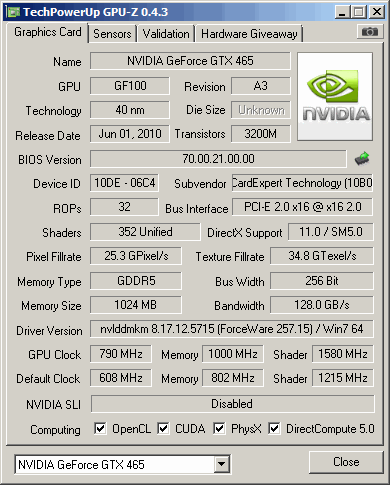
Noise
Gainward’s GTX 465 Good Edition’s cooling isn’t quite inaudible when idle, but it’s quiet enough not to bother you. We could easily hear it during gaming, but the noise was constant and didn’t change like on reference GTX 480 and GTX 470 cards. The info we have says the GTX 465 is quieter than the GTX 470.
Power Consumption
Gainward’s GTX 465 Good Edition draws about the same as the reference GTX 470, which is a direct result of the Gainward’s PCB of choice. The reference GTX 465’s TDP stands at 200W, whereas the GTX 470’s TDP is at 215W.
Our test rig consumed up to 392W with the GTX 465 Good Edition, which is comparable to the same scenario with the GTX 470 onboard – our rig consumed 395W in the latter scenario. Radeon HD 5850 however is much better as our rig drew up to 308W. Idle operation once again crowns the HD 5850, as our rig drew 146W. The same scenario saw the GTX 470 consume 149W whereas Gainward’s GTX 465 Good drew 152W.
GPU temperatures
With no overclocking, Gainward’s GTX 465 hit 87°C, while after clocking this number jumped to 93°C. This is, at the same time, the temperature on reference GTX 470 cards when running 3D. Radeon HD 5850 keeps GPU temperatures at about 41°C when idle, whereas 3D operation pushes it up to 87°C. Idle temperatures on Gainward’s GTX 465 Good Edition were at 41°C, which means that temperatures are pretty much identical to those on HD 5850 cards.
Overclocking
As you can see from the following results, after overclocking Gainward’s GTX 465 Good Edition, the card scored similarly to the GTX 470.
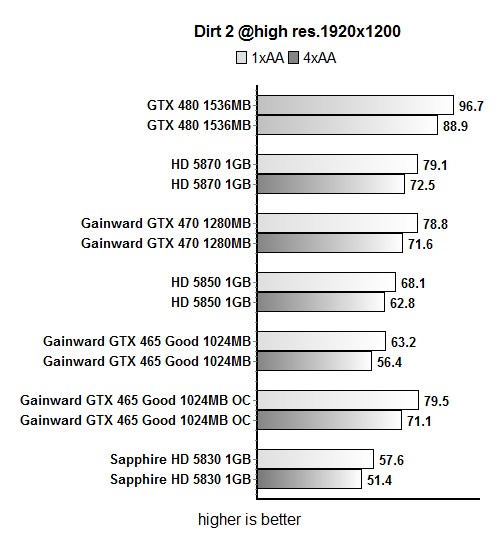

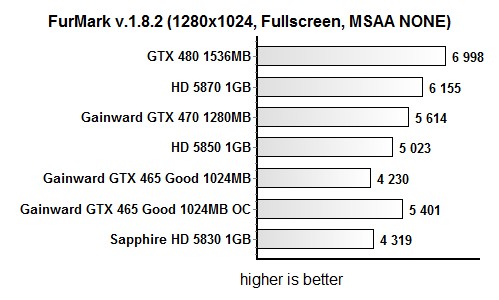
Conclusion
Gainward’s GTX 465 Good Edition is a reference clocked card, and we were pretty surprised to see that Gainward didn’t push the card further after strapping it with such a quality cooler. Still, if the clocks were higher, this card would cost more, whereas now it will set you back no more than a reference card will. In fact, the card is very close to being the most affordable GTX 465. We must say that it’s been a while since we’ve seen such overclocking potential, as we managed to push the card from 607MHz to 790MHz, which is more than 30% more juice.
Gainward managed to make one of the best GTX 465 cards around, as the card packs great overlocking potential, a fine dual-slot cooler and a standard HDMI connector (rather than Nvidia’s mini-HDMI out found on reference designs). Furthermore, the card also comes with two dual-link DVI outs and a DisplayPort connector. Note however, that only two outs can be used at the same time.
Unfortunately, such performance comes at a price and the GTX 465’s power consumption is pretty high; in fact, it’s comparable to GTX 470’s consumption.
All in all, the GTX 465 Good is indeed a “good” gaming card, and it’s some 25% slower than the GTX 470. We believe it will prove to be popular with those looking for a sub-€290 DirectX11 cards.
Unfortunately, while the GTX 465 is a pretty good card and certainly the most affordable Nvidia’s DirectX 11 product, the price is still not right, especially after considering the competition. In fact, same money can buy you an HD 5850, and you could easily see throughout our tests that the HD 5850 is simply faster.
If you’re looking for CUDA and PhysX support and are keen on purchasing Nvidia’s DirectX 11 card without having to spend a fortune, then Gainward’s GTX 465 Good card is the one for you. If its performance doesn’t blow your mind right out of the box, you can always resort to some overclocking and push the card to similar performance levels of the GTX 470.
The card is priced at about 262 euro, and you can find it here.
